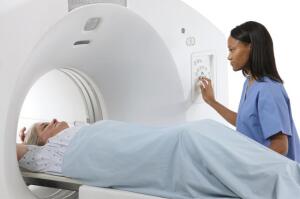by
Brendon Nafziger, DOTmed News Associate Editor | September 01, 2011

Discovery PET-CT 600 (Credit: GE)
A so-called "trimodality" system, combining PET, CT and MRI, could help further research in the clinical uses of PET-MR.
Currently being installed at a Hong Kong hospital, a pair of scanners could let radiologists compare PET-CT and sequential PET-MR reads to determine the best uses for the new modality.
"That's really the key piece: to establish where one is better than the other," Vivek Bhatt, general manager of PET with GE Healthcare, which makes the devices, tells DOTmed News.



Ad Statistics
Times Displayed: 6
Times Visited: 2 Fast-moving cardiac structures have a big impact on imaging. Fujifilm’s SCENARIA View premium performance CT brings solutions to address motion in Coronary CTA while delivering unique dose saving and workflow increasing benefits.
Considered by many to be the first new modality in a decade, PET-MR has plenty of potential: swapping out the CT with MR could allow attenuation correction for PET without exposing patients to the ionizing radiation generated by the CT scanner. Plus, MRI's ability to image soft tissue could make it superior in detecting certain cancers. But Bhatt says work still has to be done: "We're trying to answer to give a very clear clinical assessment of where it'll be used in the long-term."
GE Healthcare, headquartered in Waukesha, Wis., has not released a standalone PET-MR system of its own, but two of its rivals have.
Siemens Healthcare was the first to bat in the U.S., with its Biograph mMR device, an integrated PET-MR system capable of simultaneous imaging, getting
Food and Drug Administration clearance in June. (It also picked up a
design award this year.) Philips Healthcare also has one in the works, the Ingenuity TF PET-MR, featuring two separate units attached by a rotating patients' table. It's received
European marketing approval, but is not available in the U.S. yet.
As for clinical evidence, there have been some promising early studies. A
report from University of Munich researchers at Society of Nuclear Medicine's annual meeting in June, using the Siemens system, found PET-MR scans do about as well as PET-CT scans for attenuation correction and detecting lung, liver, spleen and bone lesions.
But many doctors think more research is needed to better understand the new technology -- and this is where the new installation could provide some help.
Headed for Hong Kong
Receiving the device trio is Hong Kong Sanatorium & Hospital, a private, 400-odd-bed, 89-year-old hospital located in Happy Valley, Hong Kong.
The system involves a GE Optima MR450w wide-bore 1.5-Tesla and the Discovery PET-CT 600. They're kept in separate rooms; in addition to the research, the hospital plans on using the PET-CT scanner and the MRI scanner independently for the normal clinical work that pays the bills. But when both are used together, the patient lies on a table that can interface with both products, without changing the patient's position, Bhatt says.

